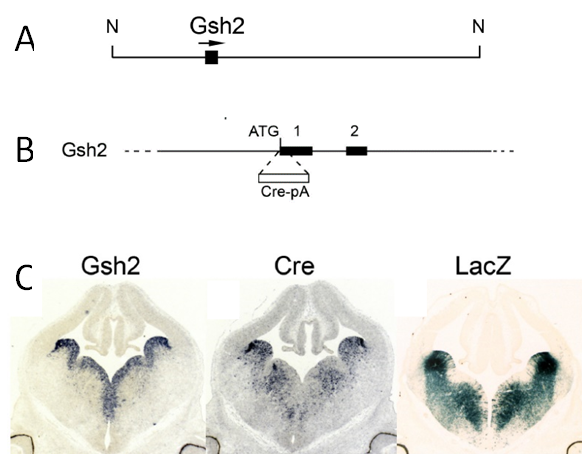Gsh2-iCre
This line is useful for driving Cre-mediated recombination of reporter lines, or for deleting floxed genes, in the neuroepithelium of the embryonic subcortical telencephalon.
To generate this line we used a 110Kb NotI genomic fragment taken from a genomic PAC isolated from library RCPI21 (Oseogawa et al., 2000). The library contains genomic DNA from a female mouse, strain 129S6/SvEvTac.
The 110Kb region used included all the Gsh2 coding exons, as well as ~25Kb upstream and ~60Kb downstream (Fig.1A). We inserted the codon-improved version of Cre recombinase (iCre) (Shimshek et al., 2002), followed by an SV40 polyadenylation signal into the Gsh2 gene, fusing iCre to the endogenous translation initiation codon (Fig.1B).
The modified PAC DNA was excised from the PAC using NotI digestion prior to generating transgenic mice by pronuclear injection. In the developing mouse embryo, transgene expression can be detected in the subcortical telencephalon (Fig.1C).
Generation of the mouse is described (Kessaris et al., 2006). The mouse is also described here:https://www.informatics.jax.org/allele/MGI:3761171 and is distributed by JAX labs: B6;CBA-Tg(Gsx2-icre)1Kess/J Strain #:025806 (https://www.jax.org/strain/025806).

Fig. 1: A: Genomic DNA used for generating the Gsh2-iCre PAC transgenic mouse. N: NotI. B: Scheme showing modification of the Gsh2 gene. C: In situ hybridization showing expression of Gsh2 and Cre and activation of a LacZ reporter gene in a Gsh2-Cre;R26R-LacZ mouse embryo at E11.5.
Placing an order on XIP
To license this product, please select the appropriate licence option on the right-hand side of this page. Terms can be previewed from the "Preview terms" link.
MTAs require agreement between all the parties involved in supplying and receiving a product. This cannot happen instantaneously but is a controlled process, managed through XIP and should not take longer no than 10 business days in ordinary circumstances.
To place an order, please locate the Sign-in or Register options on the top right side of this page. You can either sign in to your existing account or register for a new now.
For additional guidance on how to create an account and place an order, refer to the FAQs. Please note that your account should be created using your academic/ institutional e-mail address.
-
expand_more library_books References (3)
- Kessaris N, Fogarty M, Iannarelli P, Grist M, Wegner M, Richardson WD (01 February 2006), Competing waves of oligodendrocytes in the forebrain and postnatal elimination of an embryonic lineage, Nature Neuroscience, 09, 173–179
- Kazutoyo Osoegawa, Minako Tateno, Peng Yeong Woon, Eirik Frengen, Aaron G. Mammoser, Joseph J. Catanese, Yoshihide Hayashizaki, and Pieter J. de Jong (January 2000), Bacterial Artificial Chromosome Libraries for Mouse Sequencing and Functional Analysis, Genome Research, 10, 116-128
- D R Shimshek, J Kim, M R Hübner, D J Spergel, F Buchholz, E Casanova, A F Stewart, P H Seeburg, R Sprengel (08 January 2002), Codon-improved Cre recombinase (iCre) expression in the mouse, Genesis, 32, 19-26
-
expand_more cloud_download Supporting documents (1)Product brochureGsh2-iCre.pdfAdditional files may be available once you've completed the transaction for this product. If you've already done so, please log into your account and visit My account / Downloads section to view them.